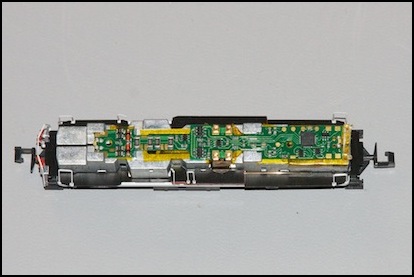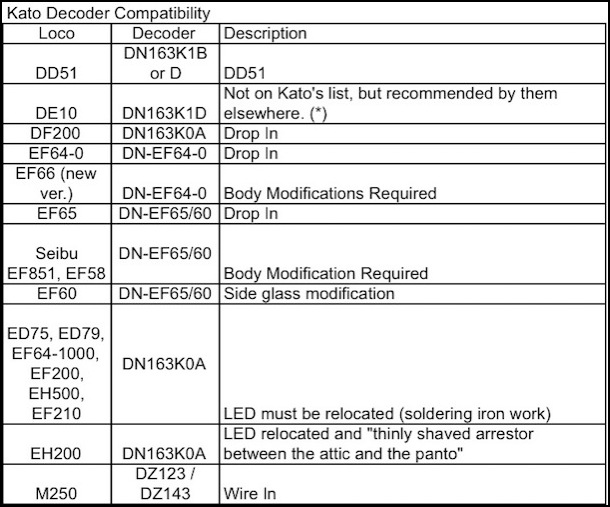Lightboard Replacement Decoders
In many locomotives, the decoder takes the place of the lightboard previously installed in it. This page summarizes decoders of that kind I’ve used or considered using. Usually this kind of decoder can be used in more than one model of locomotive, as manufacturers tend to re-use the same lightboard design across models for the sake of economy.
Lightboard decoders are inherently model-specific, so this page is to an extent organized by manufacturer and model of train, although material on the same decoder is not repeated unnecessarily.
Lightboard Decoders
Several common decoder form-factors are used across multiple models.
Kato-Compatible
Several of Kato’s locomotives can have their lightboards replaced with Digitrax boards, with a greater or lesser amount of work. Digitrax makes several “for Kato” boards, and as these also fit North American prototype locomotives, they’re available from U.S. distributors. At the easy end of the scale, the DN163K1D board is a drop in replacement for the DD51 (pity I don’t have one of those). A bit further down the scale, the EF210 can be equipped with a DN163K0A with a bit of work to modify the body shell. The DN163K0A (two “golden white” LEDs) and less commonly the DN163K0B (one “golden white” LED at the front, and solder points to add a rear LED) are used for Kato’s Japanese locomotives, with only simple modifications to the LEDs.

Kato DE10 with DN163K1D decoder installed in place of lightboard
The new DE10 takes the DN163K1D according to Kato, but I’ve discovered (via a Japanese hobbyist site, but I confirmed it myself) that there is modification to the frame required, as well as some insulating tape needed. I’m going to do a couple of these and document the process, but I haven’t done it yet. See my Kato DE10 page for details on this.
Kato’s Custom Shop has information about DCC, unfortunately it’s in Japanese, and they seem to move the pages around periodically, so links break, and some pages are scripted and can’t be linked directly. Go to their English Home Page, and find the “custom shop” link (on the Links menu), then click on the big “DCC” link (it’s a button near the bottom of the screen as of January 2012), then use Google Translate on the text of the resulting page (you can’t translated the whole page URL as you’ll get a translation of the parent page) and find the link translated as “(N) decoder with board type” (there’s also a second page with a different table under one of the untranslated graphic buttons, plus a third page with a list of their decoders). Machine translations of Japanese are notoriously bad, but Google’s does a fair job. Just remember that word order can be messed up, and loan words show up with odd phonetic spellings (e.g., “toraburushuteingu” for “troubleshooting”). I should note that I first found my way to this from a comment posted by CaptOblivious (Don G., author of the Akihabara Station blog and creator of the Rail Stars DCC systems) on the now-dormant Yamanote-sen blog. Despite previous forays into Kato’s Japanese pages, I’d never dug this deep.
In 2009 they mostly recommended the Digitrax DZ123 or DZ143 for smaller N-scale locomotives, and the DN163K0A for the larger ones. They also suggested the DN122K2 for DMU power cars and the two DZ models for other cars.
As of July 2010 this had changed, and while the DMU recommendations are mostly unchanged (and still vague), they’re recommending the DN163K0A for several models (DF50, DF200, “any other except EH10”) with various degrees of modification such as moving LEDs, they’re also recommending the “DN-EF64-0 KATO” (29-302) and “DN-EF65/60 KATO” (29-303) for several locomotives (with varying degrees of modification required). From the pictures on Kato’s website, these appear to simply be DN163K0A decoders with custom LED spacing (and Kato notes “performance is identical” to the DN163K0A). As of January 2012 the “LED must be relocated list” appears to have been deleted (I’ve retained it in the table below) except for a reference to the DF50, which had not been on the earlier list. Some of the others had also been removed from Kato’s table, likely because the lump reference to the use of the DN163K0A with resoldered LEDs applying to “all others”.
Note that the DE10 information in the table below doesn’t come from this page, but from another Kato page about the DE10 model, which as of January 2012 now recommends only the DN163K1D.
Specifically, they note:

(*) = Unclear if modification is required.
Much of the information in this section came from the JNSForum’s DCC Forum, although some was taken from Kato’s English-language manuals or other sources. Some information also came from articles on the Yamanote-Sen and Akihabara Station blogs about installing decoders in E231 trains.
Other Kato-Compatible Decoders
Vendors other than Digitrax (e.g., TCS) also make “for Kato” decoders, but there’s less info available about those, and I’m predisposed to use Digitrax so I haven’t dug into them yet.
Daisuke Ueno’s Japanese site illustrates using a shorter decoder (available in Japan) with the addition of surface-mount LEDs, however it’s not clear that this solves the light-pipe problem (it mainly seems to be done to address issue #2). Based on some email from him, this appears to be from the New Generation of DCC site, the DE22x6_DE10K 6FX, which a few folks on the JNS Forum have reported successfully ordering by sending email to the address on the website (the site’s all in Japanese, so judicious use of Google Translate or similar may be needed to find the address, but the person who runs it understands English). See this thread, this thread and this thread for comments on experience with them.
Another provider is Kumata, which is selling ESU decoders programmed with Japanese-prototype sounds (including the DE10). There are some fairly complicated instructions for ordering from outside Japan on this page, but they do take Paypal (thanks to bill937ca for the tip). I don’t know of anyone who has ordered from them, as the prices are quite steep: 21,000 yen, or $262 at today’s rates, before you add shipping, compared to $127 from U.S. provider TrainTek (but TrainTek and other domestic distributors don’t have Japanese sounds).
Train Models
Few models directly take lightboard decoders, and often minor changes such as adding or repositioning LEDs, or modifications to the structure of the model, are required. The following summarizes these, and if other pages with more detail (mine or anyone else’s) exist, provides links to them for refererence.
Kato DE10
The DE10 is a small locomotive used by many Japanese railways for switching duties, and is also used by several for light freights or passenger trains. The Kato model of the DE10 uses a lightboard with one LED at each end illuminating the headlight and number boards. There is no support for illuminated tail-lights or a cab light.
Kato recommends the Digitrax DN163K1D decoder for the DE10 on one page on their site (it’s a dynamic page, so I can’t link to that recommendation). This is essentially the same decoder as the DN163K1B except that it uses surface-mount LEDs on the board rather than external LEDs on leads. It’s also the same as the DN163K1C, except that the “C” has brass clips soldered on, and they’re oversized for the DE10 (plus it would be hard to install the lightboard with them pre-attached). Use the DN163K1D.
As noted above there are some better options if you want to order from Japanese manufacturers, but these are a little more complicated than ordering trains from one of the big hobby shops there.
The DN163K1D is not quite a drop-in replacement for the lightboard, as there is a component on the decoder that requires removing part of the weight to make space for it. This is a relatively simple thing to do, requiring only a file and some time and care. The complete process is detailed on my DCC for a Kato DE10 page.




